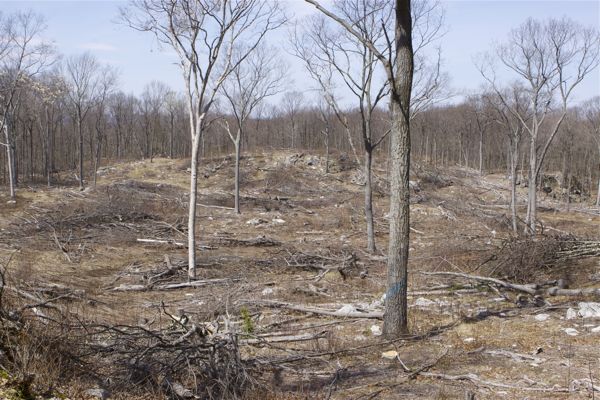Current Rationale for Logging Contradicts Prior Basis For Forest Preservation

Fragmentation, tree cuts, and opening forest canopy brings in sunlight, which fuels explosive growth of invasive plants, which out compete native plants. Source: scene from “The Highlands Rediscovered” NJN TV documentary – at time 22:40
The more cuts that one gets, the more fragmentation in this forest mosaic, the more it gets degraded. ~~~ Eric Stiles, NJ Audubon “The Highlands Rediscovered” (NJN TV, 2004)
Sportscaster Warner Wolf was famous for his line “Let’s go to the video tape!” – so, let’s do just that for a moment to shed some light (pun intended) on the current debate about logging in Highlands forests.
I’ve written thousands of words and posted numerous photos about that – particularly on how the current rationale for logging Highlands forests contradicts the science relied upon to preserve the Highlands. I’ve even used the published work of NJ Audubon CEO Eric Stiles to make the point:
Forest wildlife diversity depends on large contiguous forest patches, connections to other habitats, structurally complex vegetation, intact seasonal wetlands, and the presence of native vegetation. Disruption of any of these components can dramatically reduce wildlife diversity. ~~~ Eric Stiles, NJ Audubon (“State of the Forest” Symposium (2002)
But NJN’s documentary video does that far better, and brings in other expert voices to confirm my point (including Mr. Stiles himself!).
The 2004 NJN TV documentary “The Highlands Rediscovered” – funded by the Dodge Foundation – provides spectacular visual imagery supported by science to make a powerful argument for preserving the Highlands region, particularly the remaining forests.
Let’s go to the video tape to make our point – watch starting at time 22:00 minutes, where the impacts of development and fragmentation of forests are discussed. Pay special attention to the effects of disturbance of the forest (transcript below, emphases mine):
Richard Lathrop, PhD (Rutgers) – We are at a critical juncture, in that the Highlands still are predominantly forested. But, we are starting to see the balance shift towards greater development and less forest cover.
Narrator – a forest’s only defense is its magnitude. Even modest cuts – known as forest fragmentation – threaten its future.
Lathrop – Forest fragmentation has a whole cascading series of impacts. So, ecologists and land use planners have really started to appreciate the importance of conserving the integrity of large unbroken tracts of forest.
As we begin to open up the forest, as we put in roads, we change the microclimate.
Ted Stiles (PhD) (Rutgers) – Plant species that normally can’t live under shade in the forest are able to to be successful, so that you have different species of plants that penetrate the forest, which changes the habitat. (In Memoriam)
Lathrop– Some of those species can get in, take over, and out-compete the native species, and that’s what we’re seeing all across our forests. …
Heather Gracie – Consulting forester – We’re breaking down the infrastructure of the forest. We’re segmenting things off to a point where it lessens the value that these forest lands provide.
Eric Stiles, NJ Audubon – The more cuts that one gets, the more fragmentation in this forest mosaic, the more it gets degraded. If one is looking at a fragmented portion of the Highlands, you would see a simplified or dumbed down forest. You don’t have the rich structural stratification in the forest. You will see light gaps in the canopy that are not being replaced. There is no duff, there is no leaf litter. Just bare dirt.
Yes Mr. Stiles – One destroys the forest with those cuts –
Kind of like one sees here, after NJ Audubon cuts at Sparta Mountain:

